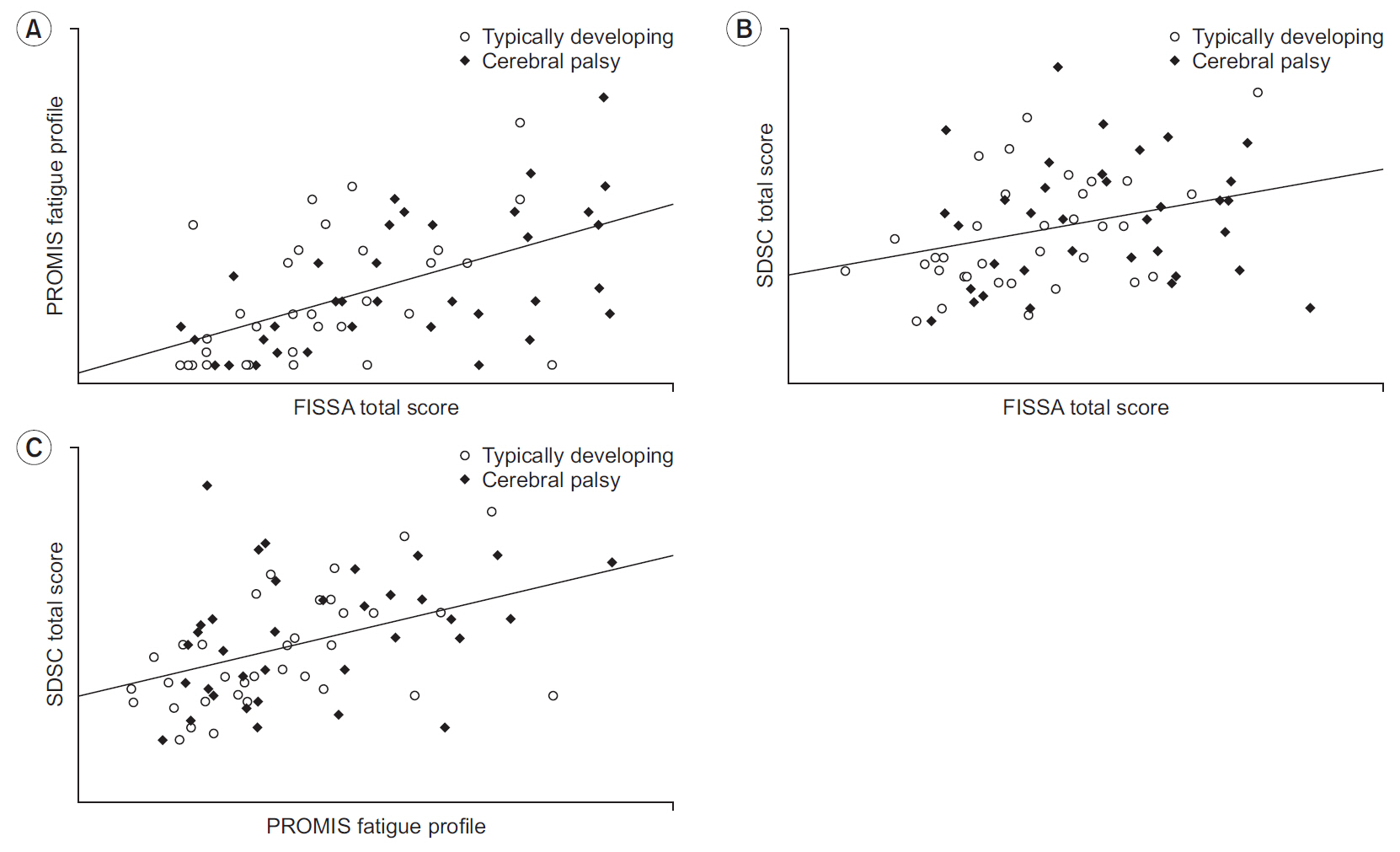Ann Rehabil Med.
2021 Jun;45(3):197-203. 10.5535/arm.20250.
More Than Just Adolescence: Differences in Fatigue Between Youth With Cerebral Palsy and Typically Developing Peers
- Affiliations
-
- 1School of Physical Therapy, Western University, London, Ontario, Canada
- 2Cumming School of Medicine, University of Calgary, Calgary, Alberta, Canada
- 3Faculty of Kinesiology, University of Calgary, Calgary, Alberta, Canada
- 4School of Allied Health, University of Limerick, Limerick, Ireland
- KMID: 2517597
- DOI: http://doi.org/10.5535/arm.20250
Abstract
Objective
To quantify differences in fatigue and disordered sleep between adolescents with cerebral palsy (CP) and their typically developing peers. A secondary aim was to investigate the association between fatigue and disordered sleep in adolescents with CP.
Methods
A convenience sample of 36 youth with CP aged 10–18 years was matched for age and sex with 36 typically developing peers. The Fatigue Impact and Severity Self-Assessment (FISSA), the Patient-Reported Outcome Measurement Information System (PROMIS) fatigue profile, and the Sleep Disturbance Scale for Children (SDSC) were collected.
Results
Higher fatigue was reported in participants with CP than in their typically developing peers based on the FISSA total score (mean paired difference=19.06; 99% confidence interval [CI], 6.06–32.1), the FISSA impact subscale (mean paired difference=11.19; 99% CI, 3.96–18.4), and the FISSA Management and Activity Modification subscale (mean paired difference=7.86; 99% CI, 1.1–14.6). There were no differences between groups in the PROMIS fatigue profile (mean paired difference=1.63; 99% CI, -1.57–4.83) or the SDSC total score (mean paired difference=2.71; 99% CI, -2.93–8.35).
Conclusion
Youth with CP experienced significantly more fatigue than their peers as assessed by a comprehensive measure that considered both general and diagnosis-specific concerns. Sleep did not differ between youth with CP and their typically developing peers. These findings underscore the need to consider the clinical management of fatigue across the lifespan of individuals with CP to prevent the associated deterioration of functional abilities.
Keyword
Figure
Reference
-
1. Carpenito-Moyet LJ. Nursing diagnosis: application to clinical practice. 11th ed. Philadelphia, PA: Lippincott Williams & Wilkins;2006.2. Currie C, Hurrlemann K, Settertobulte W, Smith R, Todd J. Health and health behaviour among young people. Copenhagen, Denmark: World Health Organization Regional Office for Europe;2000.3. Brunton LK, Bartlett DJ. Profiles of fatigue severity and variability among adolescents and young adults with cerebral palsy. Fatigue. 2017; 5:5–14.
Article4. Brunton LK, Bartlett DJ. Construction and validation of the fatigue impact and severity self-assessment for youth and young adults with cerebral palsy. Dev Neurorehabil. 2017; 20:274–9.
Article5. Carskadon MA, Wolfson AR, Acebo C, Tzischinsky O, Seifer R. Adolescent sleep patterns, circadian timing, and sleepiness at a transition to early school days. Sleep. 1998; 21:871–81.
Article6. Newman CJ, O’Regan M, Hensey O. Sleep disorders in children with cerebral palsy. Dev Med Child Neurol. 2006; 48:564–8.
Article7. Hayashi M, Inoue Y, Iwakawa Y, Sasaki H. REM sleep abnormalities in severe athetoid cerebral palsy. Brain Dev. 1990; 12:494–7.
Article8. Kotagal S, Gibbons VP, Stith JA. Sleep abnormalities in patients with severe cerebral palsy. Dev Med Child Neurol. 1994; 36:304–11.
Article9. Romeo DM, Brogna C, Quintiliani M, Baranello G, Pagliano E, Casalino T, et al. Sleep disorders in children with cerebral palsy: neurodevelopmental and behavioral correlates. Sleep Med. 2014; 15:213–8.
Article10. Van Der Slot WM, Nieuwenhuijsen C, Van Den Berg-Emons RJ, Bergen MP, Hilberink SR, Stam HJ, et al. Chronic pain, fatigue, and depressive symptoms in adults with spastic bilateral cerebral palsy. Dev Med Child Neurol. 2012; 54:836–42.
Article11. Ramstad K, Jahnsen R, Lofterod B, Skjeldal OH. Continuous intrathecal baclofen therapy in children with cerebral palsy: when does improvement emerge? Acta Paediatr. 2010; 99:1661–5.12. Lundy CT, Doherty GM, Fairhurst CB. Botulinum toxin type A injections can be an effective treatment for pain in children with hip spasms and cerebral palsy. Dev Med Child Neurol. 2009; 51:705–10.
Article13. Janzen L, Condliffe E, Toomey C, Kuntze G, Esau S, Brunton L, et al. Influence of regional lean mass on lower-extremity strength in youth with spastic cerebral palsy. Dev Med Child Neurol. 2019; 61(S3):111–2.14. Lai JS, Stucky BD, Thissen D, Varni JW, DeWitt EM, Irwin DE, et al. Development and psychometric properties of the PROMIS pediatric fatigue item banks. Qual Life Res. 2013; 22:2417–27.
Article15. Bruni O, Ottaviano S, Guidetti V, Romoli M, Innocenzi M, Cortesi F, et al. The Sleep Disturbance Scale for Children (SDSC): construction and validation of an instrument to evaluate sleep disturbances in childhood and adolescence. J Sleep Res. 1996; 5:251–61.16. Kuppuswamy A. The fatigue conundrum. Brain. 2017; 140:2240–5.
Article17. Brunton LK. Descriptive report of the impact of fatigue and current management strategies in cerebral palsy. Pediatr Phys Ther. 2018; 30:135–41.
Article18. Bolster EA, Balemans AC, de Groot V, Buizer AI, Dallmeijer AJ. Fatigue in children and young adults with physical disabilities: relation with energy demands of walking and physical fitness. Pediatr Phys Ther. 2020; 32:202–9.
Article19. Jahnsen R, Villien L, Stanghelle JK, Holm I. Fatigue in adults with cerebral palsy in Norway compared with the general population. Dev Med Child Neurol. 2003; 45:296–303.
Article20. Jahnsen R, Villien L, Egeland T, Stanghelle JK, Holm I. Locomotion skills in adults with cerebral palsy. Clin Rehabil. 2004; 18:309–16.
Article
- Full Text Links
- Actions
-
Cited
- CITED
-
- Close
- Share
- Similar articles
-
- Anxiety, Depression, and Quality of Life of Caregivers of Children with Cerebral Palsy versus Those with Typically Developing Children
- Sleep Pattern and Night-Time Muscle Activity in Children With Cerebral Palsy Compared to Typically Developing Peers
- The Effects of Integrative Art Therapy on Social Competence and Hand Function of Children with Cerebral Palsy
- Current opinion of cerebral palsy
- Emotional and Psychosocial Development in Siblings of Children with Cerebral Palsy


